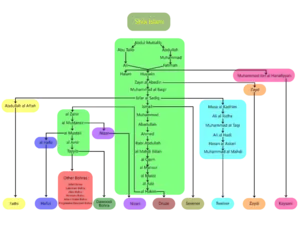Shi'a Islam
Shi'a Islam, the second-largest branch of Islam (after the Sunni branch), comprises about 20% of Muslims overall. It is the dominant form of Islam in Iran, Iraq, Bahrain, and Azerbaijan. One can subdivide Shi'as into Twelvers (Imamiyya)
| Party Like It's 632 Islam |
| Turning towards Mecca |
v - t - e |
Differences from Sunni Islam
Shiites believe that the rightful successor of Muhammad was his cousin Ali, rather than his father-in-law Abu Bakr. They also differ on the identity of the Mahdi. Twelver Shiites believe that the Mufi was Muhammad al-Mahdi who was "hidden" in the late 800s and will return someday; other Shiite communities believe that an earlier imam was in fact the Mahdi.
It has been said that Shiites are defined by martyrdom and sacrifice, possibly owing to the assassinations of Ali and his sons Hasan and Hussein, the latter of which is mourned during the piously joyless month of Muharram. [1] It's also been said that in Shi'a, Allah doesn't want blind faith but for people to arrive to him through reasoning and questioning, even of those claiming to be receiving divine revelation. [2] Karbala, Kufa, Najaf Kadhimiyyah, and Samarra are prominent Shi'a religious sites located in Iraq, but Iran has the highest percentage of its population adhering to Shi'a Islam out of any country.
Due to the difference in Hadith collections, the split of the Shi'a represents variations in non-Quranic law, which in Sunni Islam is often derived from scholarly jurisprudence. Depending on further differences between Shi'a subdivisions, the Sunni-Shi'a differences are either exacerbated or mitigated depending on the rationale used in the jurisprudence of law for each respective subdivision.
Imams are kind of like sorcerers in Dungeons and Dragons; they are born with their religious power rather than having to acquire it through book learning and proving themselves though the completion of quests for the local ummah
Aside from the Imamate bloodline, role of the Shi'a Imam, and the belief in the Occultation (or "hiding" of the Mahdi), it can be argued that jurisprudence of law differences between the mainstream representatives of each Shi'a subdivision are, in fact, rather small.
Shi'a Islam, unlike Sunni, allows for temporary marriages of a contracted amount of time called nikah mut‘ah
Theological matters may show more variance, as the historical debate between Mutazili or Ashari theology applies differently to each group. Mainstream Sunnism almost ubiquitously represents the Ashari theological line, while the Sevener Shi'a show the most Mutazili influence. Theological differences are apparent in issues including the characteristics of God, the matter of free will, the ability to rationalize the word of God, and the relationship between sin and faith.
Sects
The number or list of the infallible Imams is disputed among Shia sects.

Twelver
The most popular sect among Shias are the Twelvers. The Twelvers constitute the majority in Iran. Their last Imam was Muhammad al-Mahdi, from the 9th century who they believe will return in the end times along with Jesus.
Zaidiyyah
Zaidiyyah are a sect of Shia Muslims, primarily found in Yemen who believe that the fourth Imam was Zayd ibn Ali, grandson of Husayn (son of First Imam Ali).
Ismaili
When Ismail, the appointee and son of Sixth Imam al-Sadiq, died before the death of his father, the Ismailis were formed. They believed that his descendants should get the Imamate. The rest of the Shia regarded another of al-Sadiq's sons as the Imam. Multiple Ismaili sects still exist, including the Nizaris whose line of Imams continue till today.
References
- How Do Sunni and Shia Islam Differ?, John Harney 1/3/2016.
- Allamah Muhammad Rida Al Muzaffar (1989). The faith of Shia Islam. Ansariyan Qum. p. 1.
- "What's the Difference Between Shia and Sunni Muslims?" Huda, ThoughtCo
- "Sunnia and Shia", BBC
- Taj Hashmin; "Global Jihad and America: The Hundred-Year War Beyond Iraq and Afghanistan"; Page 50 https://books.google.com/books?isbn=9351500861